
I would like to discuss the production and rhetoric of a specific type of Internet meme, namely the image macro, and more specifically the advice animal image macro type. Now, certainly the advice animal meme-type is only one of a wide variety of Internet memes; such as emergent viral and remix videos, squee (with its obsessive display of overly cute animals), performative and participatory photo fads like planking, or the granddaddy of them all LOLcats.
I am limiting this introduction to the advice animal type: first, because they are what is most commonly referred to as memes in popular digital culture: and secondly because this will allow us to explore the form more deeply.
Advice Animal memes are everywhere. We find them on virtually every social media platform, we receive them in email, there are tumblr and youtube accounts dedicated to specific characters; they appear on reddit and 4chan as posts, reposts and comments. They’ve launched Internet stars, like the three above – overly attached girlfriend, scumbag steve, and bad luck brian.
The question is, why is this form so successful?
Or, how has this form of vernacular creativity, with a somewhat obscure beginning – in a Mario fan forum under the topic “guide to kissing” – evolved into a recognizable, easily understood form of online communication.
Before moving into a structural analysis of this meme-type, let’s first look at its history.
As you can see here, it only took about two-weeks in 2006 for the image to move from just an image – albeit edited, to what we recognize now as a meme.

That said, a meme is not a meme until it becomes a meme.
Only two of Dawkin’s original conditions for a meme are evident. We have the idea, and we have the style (roughly), but we do not yet have the behavior. To become a meme the concept and form, the idea and style require circulation and replication, sharing, alteration, and reiteration.
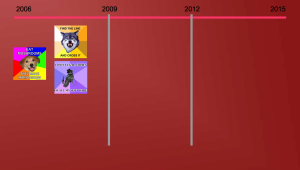
Between 2006 and 2009 the image/caption style produced in these early images slowly gained steam, but the manipulation of the image and the addition of captions were performed manually in image editing software.
Top and bottom captions, centered image, color wheel background are all there, but there are inconstancies at the level of caption placement and typography. During this time images of this sort were primarily shared in forums.
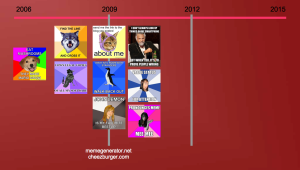
In 2009 with the launch of memegenerator.net, and the cheezburger.com builder – both generators that allow for the easy captioning of uploaded images – and throughout 2010, we start to see the form stabilize. In most cases the text is centered, and the use of the IMPACT font becomes the standard.
It is with these generators that the term image macro originates. The technology threshold of the generators is very low – upload or select an image, type your captions into a form, click on a button, and voila – the online application – running macros — outputs a potential meme.
Standardization here is, perhaps, based in the limitations of what the technology provides.
That said, with the launch of meme generators, the method is democratized; moving from a highly idiomatic, almost private form into an emergent Internet vernacular. We see the advice animal meme type start to move away from the use of generic, almost totemic animals placed on color wheel backgrounds toward the use of human faces, though perhaps still almost totemic.
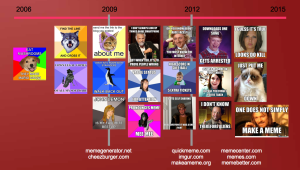
From 2011 onward, with the proliferation of meme generators, we really start to see image macros move out of forums, to be shared across various social media platforms – from facebook to twitter, instagram to tumblr, etc. They are adopted into advertising, which they borrowed from, formally, in the first place. They become a communicative behavior – highly participatory, heavily vernacular; common, understood.
It is through the behaviors – seeing, understanding, producing, reproducing, sharing — that the meme becomes a meme. And, really, Dawkin’s should be satisfied. We have a rather developed idea, we have a consistent style reproduced by many, and we have established behaviors for perpetuating the idea and the style.
That said, any given image macro may not be considered a meme. Rather, it is the form that is memetic. Or, to edit McLuhan for our purposes, we might want to say – The medium is the meme…
We also enter an age of Internet celebrity for the personalities included in the various macros: the face becomes a meme in itself…
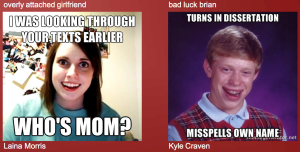
…perhaps most notably Overly Attached Girlfriend, or Laina Morris who has parlayed attention from the meme into sponsorship deals, television appearances, appearances at conventions, etc. This is not the case for all image macro personalities for sure, but I will add that Bad Luck Brian’s luck was not so bad, as he earned upwards of 20,000 a year from 2012 through 2014 for his presence on the meme…
But let’s move on.
In general, Internet memes have pretty much been considered frivolous digital artifacts. Because of their adoption into online public discourse however, it is important to consider how they operate rhetorically, beyond the punch line. Memes are more than artifacts. They are a form of Internet currency that allows us to reflect on networks, circulation, digital and popular culture.
As Davi Johnson Thornton stated in 2007,
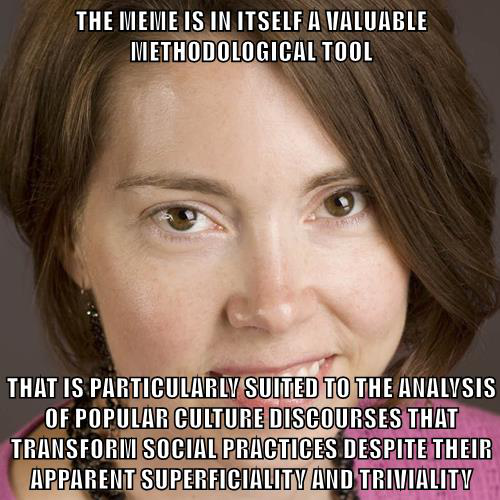
Now, to understand the meme as methodological tool, we must understand the methods of the tool.
So, let’s explore some of the rhetorical methods of advice animal image macros by way of structural analysis.
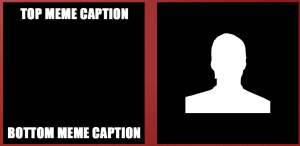
We’ll start with some commutation testing.
The images shown here break down the meme type into its most fundamental elements – captions and figure. This is the framework we will be working with.
Though absent of any real content, there is already an evident formal syntax, or design logic – the paradigms top caption, bottom caption, and figure have been fairly consistent since around 2006 –we see these in Advice Dog, in Grumpy Cat, Overly Attached Girlfriend; In Condescending Wonka, and Bad Luck Brian.
Formally, all of these memes are nearly identical. Rhetorically, however they are quite different. Let’s consider the captions…
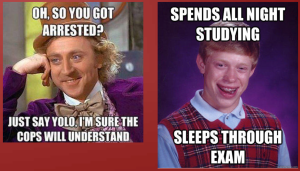
How can we describe what is going on with these? How are the rhetorical turns between top caption and bottom caption similar or different between these two macros?
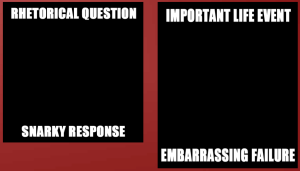
What would happen if we transposed the captions from one macro to the other?
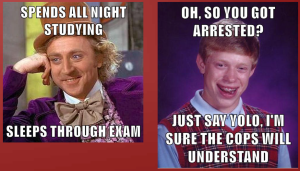
What this demonstrates is that the top caption – bottom caption pairing are not transposable one figure to another; that there is a clear association between the captions and the figure – that any meaning or humor inferred from the macro is based on the entire syntagm. And, as such each macro forms a paradigm in and of itself.
That said, we could do a paradigmatic analysis on each individual element of the advice animal framework and come up with a rather lengthy list of substitutions for each value. Here are just a few.
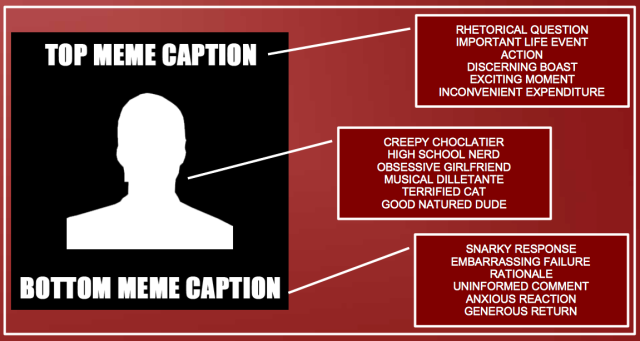
Memes find their rhetorical potency through variation, or alteration. And, for the most part this occurs laterally. As long as the paradigmatic structure of any given macro is recognizable, the generic syntagm can be maintained yet allow for transformation.
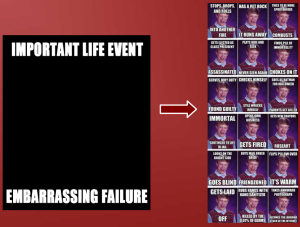
The correspondence between figure and rhetorical turn is key. In the case of Bad Luck Brian, as long as important life event returns embarrassing failure and is presented with the Brian figure the variations are essentially countless.
As an example of this sort of rhetorical portability, I developed the following images to address my own interest while maintaining the Bad Luck Brian syntagm.

Returning to the two macros in question here, typography should also be addressed as a key component of the generic paradigm of image macros.
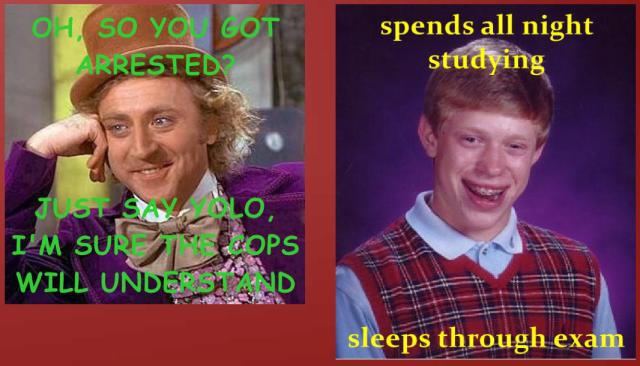
By changing the font face from Impact to any other font, by using lower case rather than all caps, by switching the color to something more vibrant the image becomes less recognizable as a meme. It should be noted that Impact is the default font for most meme generators and although most generators allow for typographical changes this feature is largely ignored.
Memes are ultimately not about unboundedness; rather, they are about commutability within tightly woven syntactic and paradigmatic structures. Which makes them both infectious and efficacious…
As more and more image macros are generated, and more and more memes emerge, we can start to understand them as bricolage; in that, to quote Levi-Strauss, they “ … construct a system of paradigms with the fragments of syntagmatic chains.” .. by appropriating pre-existing material. In this regard they are also highly intertextual, or as Genette would have it “transtextual.”
Meme generators allow a user to select an image from a vast database of images uploaded by other users or by the developers of the site. The user may also choose to uploaded an image, but either way – through selection or upload – the generator introduces the user into a process of communicating ideas through “the medium of things” – things being appropriated or leveraged digital objects. The addition of captions inscribes ideology as reading, alteration, and commutation of the image.
What we can say about memes in general is that, like all texts, they are socially negotiated. Their use-value is variable, they may be considered tactical, they maybe considered junk. None-the-less, they are in wide use online, and as such, demand critical attention as writing, as communication, as social practice, as public discourse.
Image Macros as Public Discourse
Don't Believe Every Meme ·
One Does Not Simply Generate a Meme ·
Yo-Dawg
Talan Memmott
Davin Heckman
Claire Donato
Sergio Figueiredo
Jeremy Hight
Jeff T. Johnson
Kelly Lydick
Mark Marino
Craig Saper
Orchid Tierney
Erik Zepka